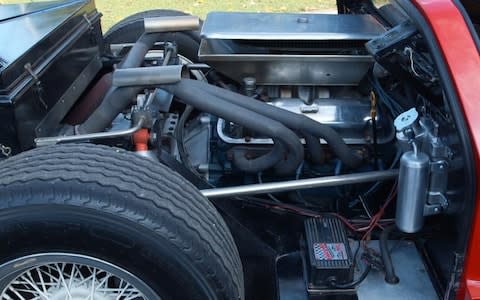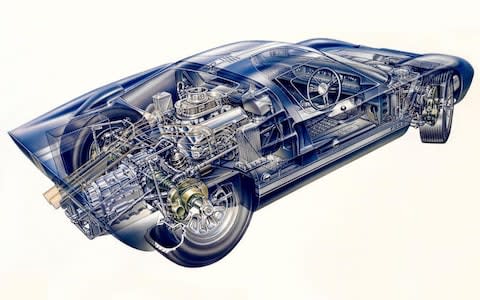Blue collar hero: driving the Ford that beat Ferrari at Le Mans

The Ford GT40 took on the might of Ferrari at Le Mans and came away the victor - repeatedly. Paul Hudson squeezes behind the wheel
The subject of the greatest British cars ever made has provided heated debate throughout the land, not least in the Telegraph Cars office. So when our colleagues at Classic & Sports Car magazine launched just such a competition, we were more than intrigued – especially since the winner was to be decided by the great British public.
The magazine asked 100 leading experts – including the likes of McLaren F1 designer Gordon Murray, Lotus head of design Russell Carr and Pink Floyd drummer and noted car collector Nick Mason – to nominate their top 10, deliberately leaving the interpretation of “best” up to them. According to James Elliott, the magazine’s group editor, “some judged their favourites solely on performance, others on historical importance, a few on coolness or packaging, but the result was an incredible mix that reflected the variety of the British motor industry”.
One of the cars that scored highly on all the above criteria was the Ford GT40, built in response to Ferrari’s dominance at the Le Mans 24 Hours from 1960 to 1965. Ford had been in negotiations to buy the Italian sports car maker but Enzo Ferrari pulled out of the deal at a late stage – and Ford vowed to conquer Le Mans in response.

The American giant established the Ford Advanced Vehicles factory in Slough to build the racers. It was overseen by Eric Broadley, whose Lola sports racing cars had used Ford V8 engines and the GT40 was constructed along similar lines, with a steel tub and the 4,727cc V8 installed immediately behind the cockpit, with the five-speed ZF gearbox hanging off the back.
It wasn’t particularly cutting-edge, but it was effective – not only on the racetrack, including the famous 1-2-3 finish in 1966 (the GT40's third year at Le Mans), but also doing wonders for Ford’s public image.
According to Elliott: “There was more debate over the Ford GT40 than any other car on the shortlist. ‘It’s a racing car,’ said some. ‘Hell, it’s not even British,’ chimed others. Even so, with nearly 40 specifically road-going examples built (including all seven MkIIIs from 1967-69) it easily garnered enough votes to make the top 10.”
Without going into too much detail, there were four variants of the GT40. MkI and II cars were broadly similar apart from engine capacity, while the MkIII was a road-going version with a longer tail to include vestigial luggage space and a few other modifications for road use. But it was still very much a racing car, the main changes being limited to suspension springing, seating and some silencers.

The name is a derivation of the car’s height in inches, so it sits low and you wonder how on earth you’re going to get in, despite the doors cutting well into the roof.
The longer tail, which accommodates a lidded black metal box that’s laughingly referred to as luggage space, lacks the well-known stubby look of MkI and II cars, although the front is all but identical.
First, you climb over the wide sill (in which lurk fuel tanks either side) then stand on the seat before submarining down into a driving position that’s best described as snug. The sloping seats allow no room for movement whatsoever, but the three-spoke Mota Lita alloy steering wheel is perfectly placed, while your feet encounter a proper racing pedalbox that made me wish I’d swapped sensible shoes for narrow racing boots.
The substantially different MkIV was developed in the US and won at Le Mans in 1967, but the regulations were changed and the Ford 7.0-litre V8 wasn’t eligible so the MkI was reintroduced and added to the victory tally in 1968 and 1969.
We tested a MkIII belonging to Ford’s heritage collection. It has been owned by the company since new and is one of only seven road-going GT40s made.The instruments seem haphazard, but it’s all about going fast, so the speedometer is on the left, farthest from view, with the tachometer directly ahead. In a nod to civility, the gear lever is in the centre, although the racers had a right-hand change alongside the sill.

Turn the key and there isn’t the racket you might expect, just the offbeat rumble of a large capacity V8. Select first in the wonderfully mechanical-feeling gearbox and prod the accelerator, and that rumble takes on a harder edge on the way to becoming a bellow.
You have to be careful with the gearbox but once learned it’s a brilliantly precise thing, although I wouldn’t trust myself not to miss a gear during a three-hour stint at Le Mans. No matter here, as it’s so easy to bowl along on a massive wave of torque.
I’d expected the steering to be spectacularly heavy but it’s not, even during low-speed manoeuvring. It even has a decent turning circle. But low speeds aren’t what this car is about. Pick up the pace and it comes alive, providing so much feedback from all the major controls that it would be tiring on a long journey. As ever, it makes you appreciate the efforts of the men who raced them.
But it’s not ultra-stiff like a modern racer. There’s a lovely compliance to the suspension that lets it ride road imperfections, while the racing drivers would have used the relatively soft set-up to drift the car through corners.
Watch: Paul Hudson stretches the GT40's legs See (and hear) the Ford GT40 out on the road
Of course, it’s totally impractical as a road car. There’s no space, the doors open so wide you’d need three parking bays at the supermarket and the view out of the back is so poor that reversing is an act of faith. And it gets really hot in there; your weekly shop in the back would be cooked or melted after a few minutes.
But that’s to be expected. The abiding impression is the view of the curvaceous wings as the car responds to the most minute adjustments to the steering wheel and, of course, the sheer drama of the bellowing V8 inches from your head.
At its launch the MkIII cost £7,540. Ford values this one at a million plus, but that has to be an ultra-conservative estimate. But even if you had the money it’s unlikely anyone would want to sell theirs, such is the car’s contribution to automotive history.
And the winner of the greatest British car award? It’s the Jaguar E-type. The car on the stand at Classic & Sports Car – The London Show this weekend is 77 RW, the car that Jaguar test driver Norman Dewis drove from Coventry to Geneva for the motor show in 1961 and the oldest-surviving open E-type. It joins all of the 10 shortlisted cars for a spectacular £30 million celebration of the best of British on one stand.
I was a bit upset when I found out, as I’ve developed a soft spot for the GT40. But does an American-funded racer for the road deserve its place in the pantheon of the greatest British cars? Most certainly.
THIS ARTICLE WAS FIRST PUBLISHED IN OCTOBER 2015
For tips and advice, visit our Advice section, or sign up to our newsletter here
To talk all things motoring with the Telegraph Cars team join the Telegraph Motoring Club Facebook group here

 Yahoo Finance
Yahoo Finance 